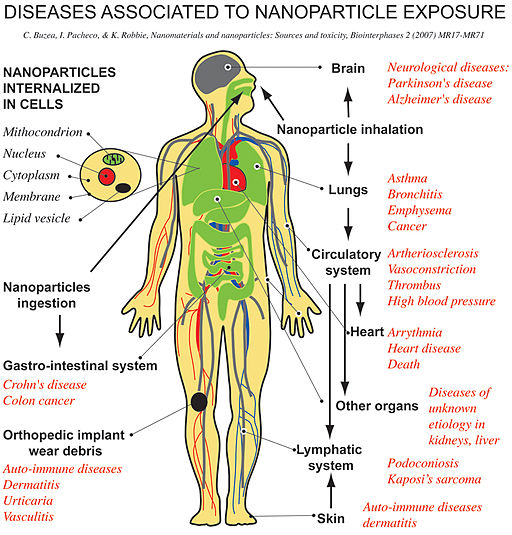Nanomaterials Safety Guidelines
Introduction
- The National Institute for Occupational Safety and Health (NIOSH) is the lead federal agency for research on the occupational safety and health implications of nanomaterials.
- Although the risks of nanomaterials to human health and the environment are largely unknown, it is prudent to stay current with information and recommendations for handling nanomaterials from NIOSH and other authoritative sources.
- This webpage is intended to make health and safety information available to our faculty, staff, students and visitors who work with engineered nanomaterials.
Definition and Examples
- Nanomaterials (nanoparticles) are materials or particles with any external dimension in the nanometer scale (from 1 nm to 100 nm) or having internal or surface structures in the nanometer scale.
- Nanoparticles that are naturally occurring (e.g. volcanic ash or soot from forest fires) or are the incidental byproducts of combustion processes (e.g. welding, diesel engines) are usually physically and chemically heterogeneous, and are often termed ultrafine particles.
- Engineered nanomaterials are artificially produced, and designed with very specific properties related to their shape, size, surface, and chemistry.
- Unbound engineered nanoparticles (UNP) are engineered nanomaterials that, under normal temperature and pressure conditions, are not contained within a matrix that would reasonably be expected to prevent the particles from being separately mobile and a potential source of exposure.
| Type | Examples |
|
Carbonaceous compounds |
Carbon nanotubes and their derivatives and fullerenes |
|
Metals and metal oxides |
Titanium Dioxide (Titania), Zinc Oxide, Cerium Oxide (Ceria), Aluminum oxide, Iron Oxide, Silver, Gold, and Zero Valent Iron (ZVI) nanoparticles |
|
Semi-conductor devices |
Quantum dots: ZnSe, ZnS, ZnTe, CdS, CdTe, CdSe, GaAs, AlGaAs, PbSe, PbS, InP |
|
Polymers |
Polymer nanoparticles (nanospheres and nanocapsules), polymer nanofibers |
Potential Hazards
- Inhaled nanomaterials may be deposited in the respiratory tract and may cause inflammation and damage to lung cells and tissues
- Certain nanomaterials may penetrate cell membranes and may cause damage to intracellular structures and cellular functions.
- Some nanomaterials may be pyrophoric or readily combustible, creating a risk of explosions and fires.
 Exposures to nanomaterials may occur through inhalation, dermal contact, accidental
injection, and ingestion, and the risk increases with duration of exposure and the
concentrations of nanoparticles in the sample or air. Inhalation presents the greatest
exposure hazard. Nanomaterials suspended in a solution or slurry pose a lesser hazard,
however, sonication, shaking, stirring, pouring, or spraying can result in inhalation
exposure. Nanoparticles that are fixed within a matrix pose the least hazard as long
as no mechanical disruption, such as grinding, cutting, or burning, occurs.
Exposures to nanomaterials may occur through inhalation, dermal contact, accidental
injection, and ingestion, and the risk increases with duration of exposure and the
concentrations of nanoparticles in the sample or air. Inhalation presents the greatest
exposure hazard. Nanomaterials suspended in a solution or slurry pose a lesser hazard,
however, sonication, shaking, stirring, pouring, or spraying can result in inhalation
exposure. Nanoparticles that are fixed within a matrix pose the least hazard as long
as no mechanical disruption, such as grinding, cutting, or burning, occurs.

U.S. Department of Energy graded exposure risk for nanomaterials. This figure assumes that no disruptive force (e.g., sonication, grinding, burning) is applied to the matrix.
Recommended Work Practices
Risk assessment
- Conduct a thorough risk assessment to identify the control measures needed and determine if the controls used are effective in reducing exposure.
Engineering controls
- Do not use horizontal laminar-flow hoods (clean benches) that direct a flow of air into the user’s face.
- Use ventilated enclosures (e.g. glove box) or local exhaust ventilations that operate at a negative pressure and are equipped with HEPA filters (a laboratory chemical hood might be too turbulent for manipulating).
Administrative Controls
- Establish procedures to address cleanup of nanomaterial spills and decontamination of surfaces. For example, dry sweeping or use of compressed air for cleanup is prohibited; use wet wiping and vacuum cleaners equipped with HEPA filters.
- Nanomaterials should be stored in labeled containers that indicate their chemical content and form; include term “nano” in descriptor, e.g., “nano zinc oxide particles” rather than just “zinc oxide”. Click here to download the label for nanomateiral sample
Personal Protective Equipment
- Closed-toe shoes made of low-permeability materials
- Long pants and long sleeved shirt
- Safety glasses with side shields or chemical splash goggles
- Lab coats
- Chemical resistant/impermeable gloves
- Additional PPE may be specified for different labs.
Disposal
- Do not dispose of nanomaterials down the drain or in the regular trash.
- When disposing of dry nanomaterials waste, or items that may have been in contact with nanomaterials, such as PPE, wipes, et al, use a sealable plastic bag or container with tight fitting cap.
If you are planning to work with nanomaterials and would like assistance with appropriate engineering control selection, procedure development, or hazard waste disposals, contact us at 631-632-6410 or LabSafety@stonybrook.edu.
References and Additional Related Resources
- NIOSH/General safe practices for working with engineered nanomaterials in research laboratories
- NIOSH/Nanotechnology Topic Page
- NIOSH/Approaches to safe nanotechnology
- The National Nanotechnology Initiative (NNI)-Federal R&D program established to coordinate the multiagency efforts in nanoscale science, engineering, and technology
- OSHA Nanotechnology Safety and Health Topics
- OSHA Fact Sheet: Working Safely with Nanomaterials
- EPA nanotechnology and Nanomaterials Research
